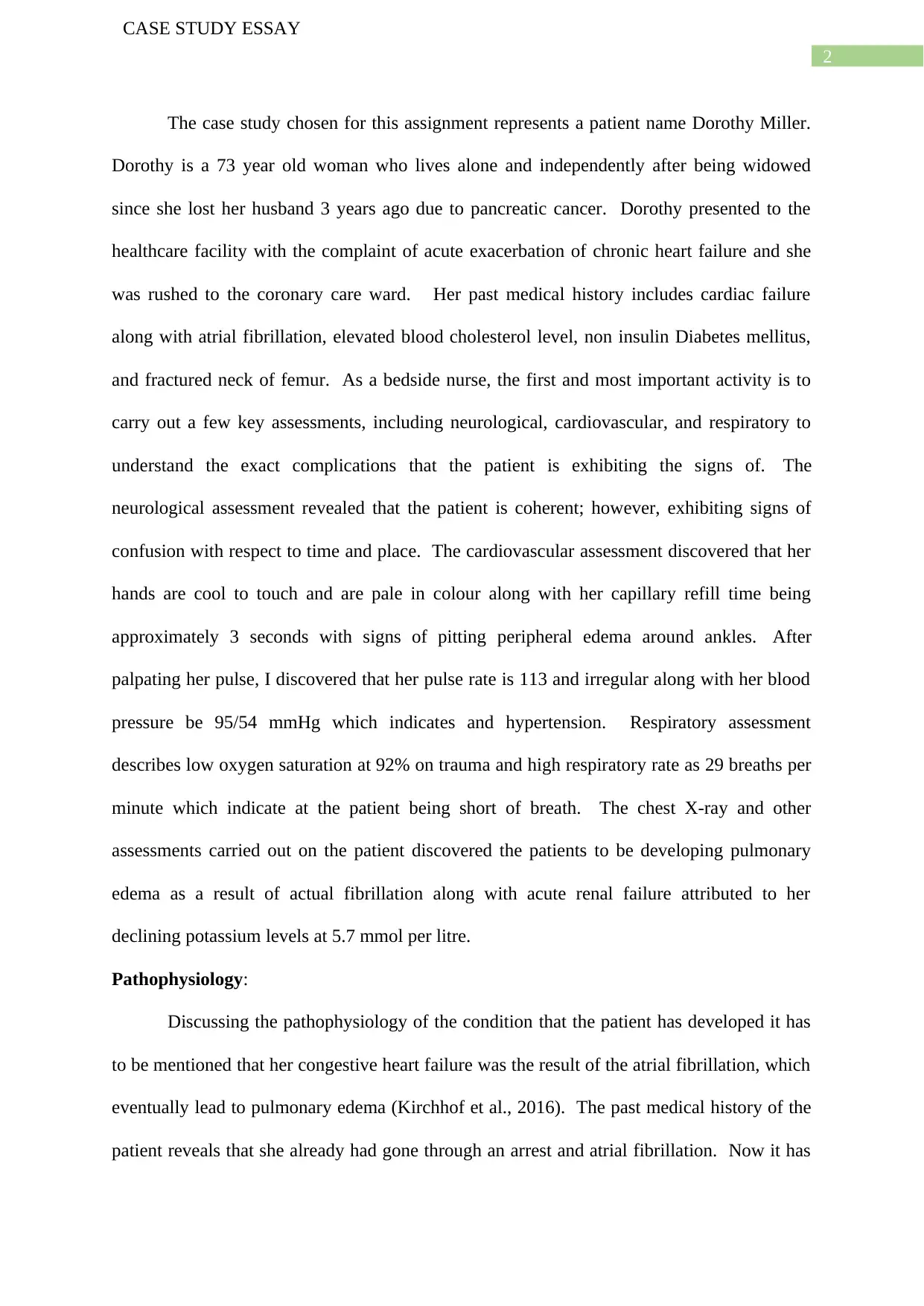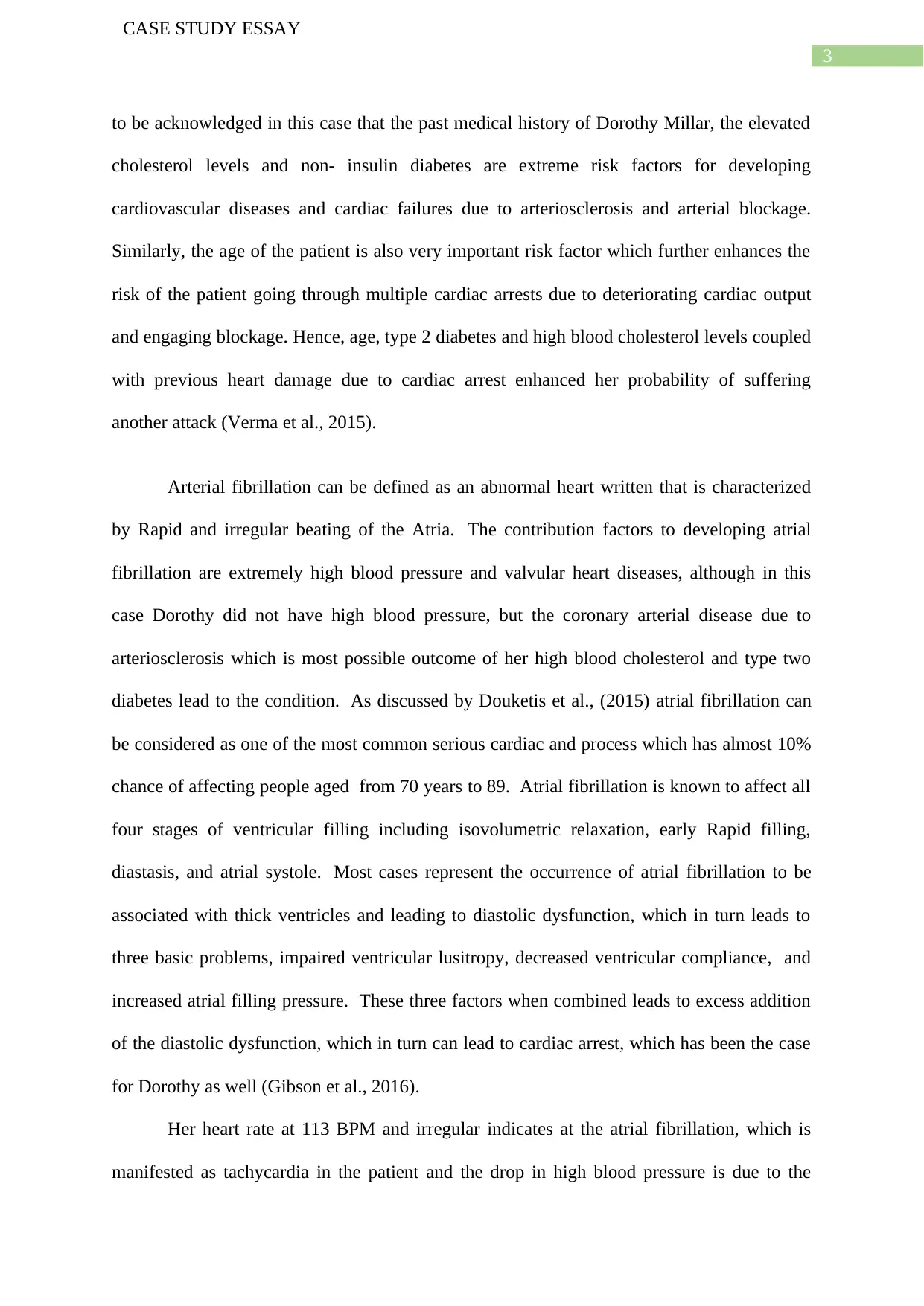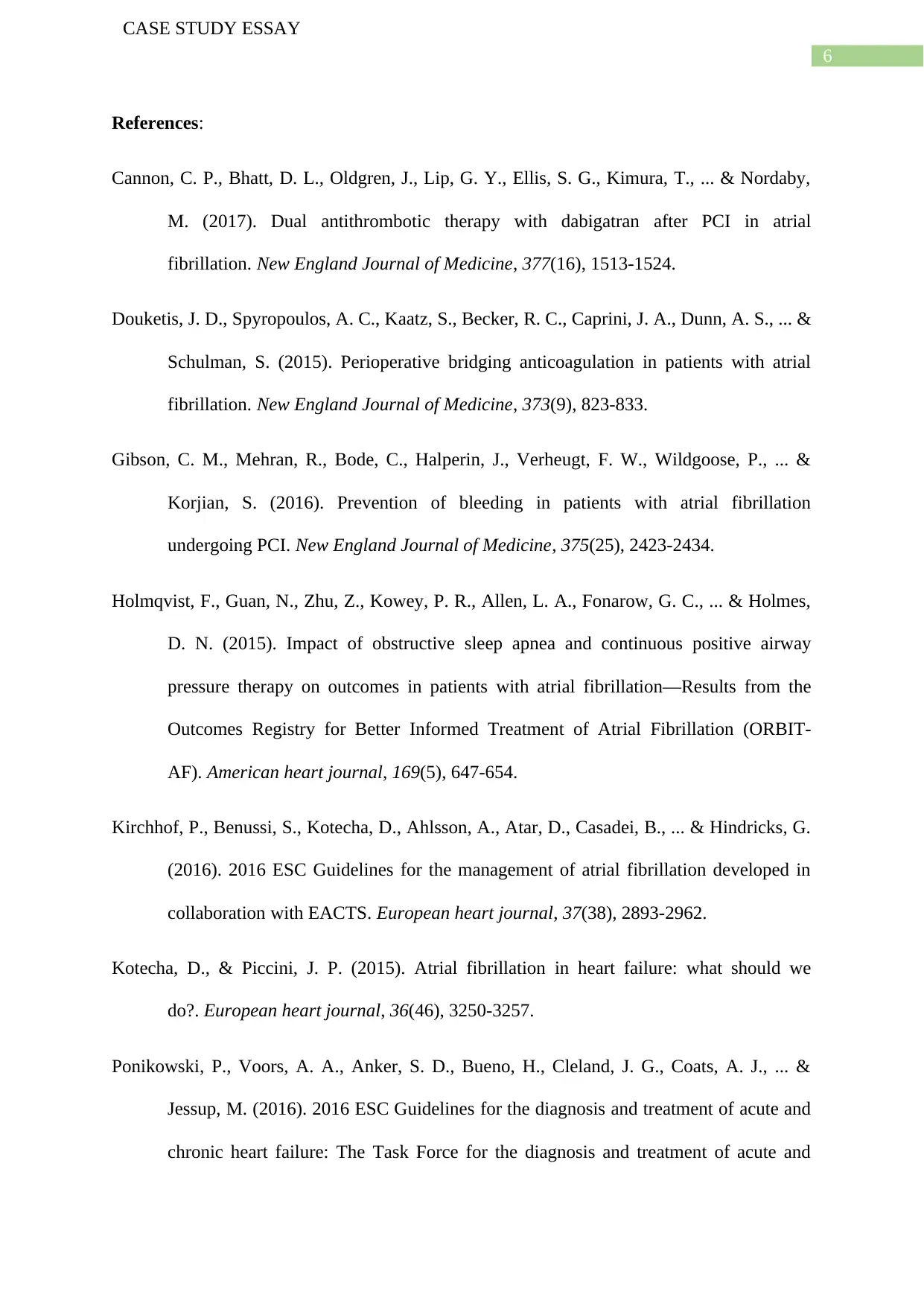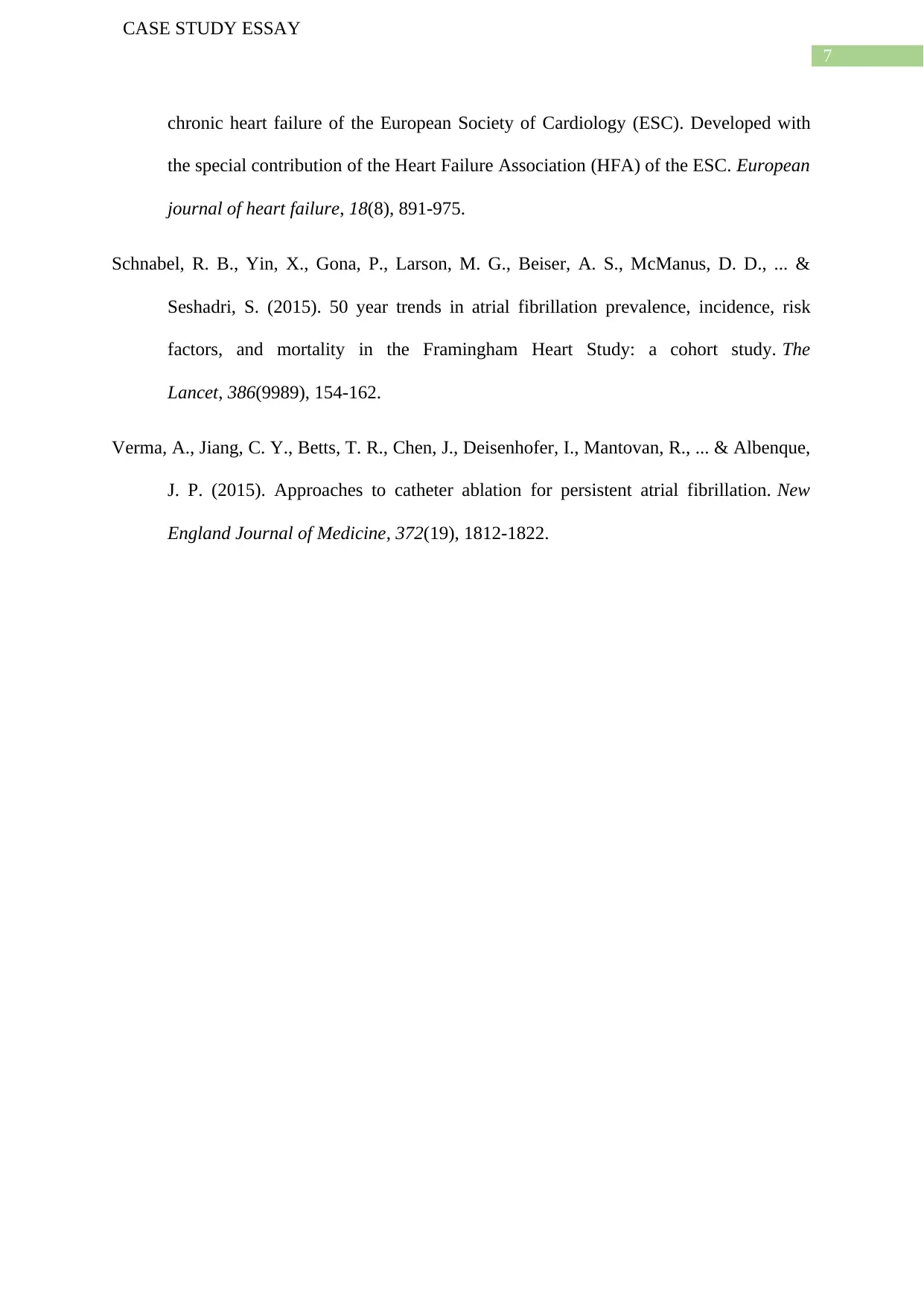NSB236 Integrated Nursing Practice 3: Case Study of Heart Failure
VerifiedAdded on 2023/04/22
|7
|2040
|269
Case Study
AI Summary
This case study focuses on Dorothy Miller, a 73-year-old woman with a history of cardiac failure, atrial fibrillation, diabetes, and other conditions, who presented with acute exacerbation of chronic heart failure and acute renal failure. The study details the initial assessments, revealing neurological, cardiovascular, and respiratory complications, including confusion, cool extremities, irregular pulse, hypertension, and low oxygen saturation. The pathophysiology discusses how atrial fibrillation led to pulmonary edema, exacerbated by her medical history of elevated cholesterol and diabetes. Interventions include pharmacological treatments like diuretics, beta-blockers, and intravenous electrolytes to manage cardiac dysfunction, fluid volume imbalance, and prevent renal failure. The priority is addressing cardiac dysfunction and atrial fibrillation to stabilize vital signs and mitigate immediate risks.

Running head: CASE STUDY ESSAY
Case study essay
Name of the student:
Name of the university:
Author note:
Case study essay
Name of the student:
Name of the university:
Author note:
Paraphrase This Document
Need a fresh take? Get an instant paraphrase of this document with our AI Paraphraser

2
CASE STUDY ESSAY
The case study chosen for this assignment represents a patient name Dorothy Miller.
Dorothy is a 73 year old woman who lives alone and independently after being widowed
since she lost her husband 3 years ago due to pancreatic cancer. Dorothy presented to the
healthcare facility with the complaint of acute exacerbation of chronic heart failure and she
was rushed to the coronary care ward. Her past medical history includes cardiac failure
along with atrial fibrillation, elevated blood cholesterol level, non insulin Diabetes mellitus,
and fractured neck of femur. As a bedside nurse, the first and most important activity is to
carry out a few key assessments, including neurological, cardiovascular, and respiratory to
understand the exact complications that the patient is exhibiting the signs of. The
neurological assessment revealed that the patient is coherent; however, exhibiting signs of
confusion with respect to time and place. The cardiovascular assessment discovered that her
hands are cool to touch and are pale in colour along with her capillary refill time being
approximately 3 seconds with signs of pitting peripheral edema around ankles. After
palpating her pulse, I discovered that her pulse rate is 113 and irregular along with her blood
pressure be 95/54 mmHg which indicates and hypertension. Respiratory assessment
describes low oxygen saturation at 92% on trauma and high respiratory rate as 29 breaths per
minute which indicate at the patient being short of breath. The chest X-ray and other
assessments carried out on the patient discovered the patients to be developing pulmonary
edema as a result of actual fibrillation along with acute renal failure attributed to her
declining potassium levels at 5.7 mmol per litre.
Pathophysiology:
Discussing the pathophysiology of the condition that the patient has developed it has
to be mentioned that her congestive heart failure was the result of the atrial fibrillation, which
eventually lead to pulmonary edema (Kirchhof et al., 2016). The past medical history of the
patient reveals that she already had gone through an arrest and atrial fibrillation. Now it has
CASE STUDY ESSAY
The case study chosen for this assignment represents a patient name Dorothy Miller.
Dorothy is a 73 year old woman who lives alone and independently after being widowed
since she lost her husband 3 years ago due to pancreatic cancer. Dorothy presented to the
healthcare facility with the complaint of acute exacerbation of chronic heart failure and she
was rushed to the coronary care ward. Her past medical history includes cardiac failure
along with atrial fibrillation, elevated blood cholesterol level, non insulin Diabetes mellitus,
and fractured neck of femur. As a bedside nurse, the first and most important activity is to
carry out a few key assessments, including neurological, cardiovascular, and respiratory to
understand the exact complications that the patient is exhibiting the signs of. The
neurological assessment revealed that the patient is coherent; however, exhibiting signs of
confusion with respect to time and place. The cardiovascular assessment discovered that her
hands are cool to touch and are pale in colour along with her capillary refill time being
approximately 3 seconds with signs of pitting peripheral edema around ankles. After
palpating her pulse, I discovered that her pulse rate is 113 and irregular along with her blood
pressure be 95/54 mmHg which indicates and hypertension. Respiratory assessment
describes low oxygen saturation at 92% on trauma and high respiratory rate as 29 breaths per
minute which indicate at the patient being short of breath. The chest X-ray and other
assessments carried out on the patient discovered the patients to be developing pulmonary
edema as a result of actual fibrillation along with acute renal failure attributed to her
declining potassium levels at 5.7 mmol per litre.
Pathophysiology:
Discussing the pathophysiology of the condition that the patient has developed it has
to be mentioned that her congestive heart failure was the result of the atrial fibrillation, which
eventually lead to pulmonary edema (Kirchhof et al., 2016). The past medical history of the
patient reveals that she already had gone through an arrest and atrial fibrillation. Now it has

3
CASE STUDY ESSAY
to be acknowledged in this case that the past medical history of Dorothy Millar, the elevated
cholesterol levels and non- insulin diabetes are extreme risk factors for developing
cardiovascular diseases and cardiac failures due to arteriosclerosis and arterial blockage.
Similarly, the age of the patient is also very important risk factor which further enhances the
risk of the patient going through multiple cardiac arrests due to deteriorating cardiac output
and engaging blockage. Hence, age, type 2 diabetes and high blood cholesterol levels coupled
with previous heart damage due to cardiac arrest enhanced her probability of suffering
another attack (Verma et al., 2015).
Arterial fibrillation can be defined as an abnormal heart written that is characterized
by Rapid and irregular beating of the Atria. The contribution factors to developing atrial
fibrillation are extremely high blood pressure and valvular heart diseases, although in this
case Dorothy did not have high blood pressure, but the coronary arterial disease due to
arteriosclerosis which is most possible outcome of her high blood cholesterol and type two
diabetes lead to the condition. As discussed by Douketis et al., (2015) atrial fibrillation can
be considered as one of the most common serious cardiac and process which has almost 10%
chance of affecting people aged from 70 years to 89. Atrial fibrillation is known to affect all
four stages of ventricular filling including isovolumetric relaxation, early Rapid filling,
diastasis, and atrial systole. Most cases represent the occurrence of atrial fibrillation to be
associated with thick ventricles and leading to diastolic dysfunction, which in turn leads to
three basic problems, impaired ventricular lusitropy, decreased ventricular compliance, and
increased atrial filling pressure. These three factors when combined leads to excess addition
of the diastolic dysfunction, which in turn can lead to cardiac arrest, which has been the case
for Dorothy as well (Gibson et al., 2016).
Her heart rate at 113 BPM and irregular indicates at the atrial fibrillation, which is
manifested as tachycardia in the patient and the drop in high blood pressure is due to the
CASE STUDY ESSAY
to be acknowledged in this case that the past medical history of Dorothy Millar, the elevated
cholesterol levels and non- insulin diabetes are extreme risk factors for developing
cardiovascular diseases and cardiac failures due to arteriosclerosis and arterial blockage.
Similarly, the age of the patient is also very important risk factor which further enhances the
risk of the patient going through multiple cardiac arrests due to deteriorating cardiac output
and engaging blockage. Hence, age, type 2 diabetes and high blood cholesterol levels coupled
with previous heart damage due to cardiac arrest enhanced her probability of suffering
another attack (Verma et al., 2015).
Arterial fibrillation can be defined as an abnormal heart written that is characterized
by Rapid and irregular beating of the Atria. The contribution factors to developing atrial
fibrillation are extremely high blood pressure and valvular heart diseases, although in this
case Dorothy did not have high blood pressure, but the coronary arterial disease due to
arteriosclerosis which is most possible outcome of her high blood cholesterol and type two
diabetes lead to the condition. As discussed by Douketis et al., (2015) atrial fibrillation can
be considered as one of the most common serious cardiac and process which has almost 10%
chance of affecting people aged from 70 years to 89. Atrial fibrillation is known to affect all
four stages of ventricular filling including isovolumetric relaxation, early Rapid filling,
diastasis, and atrial systole. Most cases represent the occurrence of atrial fibrillation to be
associated with thick ventricles and leading to diastolic dysfunction, which in turn leads to
three basic problems, impaired ventricular lusitropy, decreased ventricular compliance, and
increased atrial filling pressure. These three factors when combined leads to excess addition
of the diastolic dysfunction, which in turn can lead to cardiac arrest, which has been the case
for Dorothy as well (Gibson et al., 2016).
Her heart rate at 113 BPM and irregular indicates at the atrial fibrillation, which is
manifested as tachycardia in the patient and the drop in high blood pressure is due to the
⊘ This is a preview!⊘
Do you want full access?
Subscribe today to unlock all pages.

Trusted by 1+ million students worldwide

4
CASE STUDY ESSAY
diastolic dysfunction, which in turn reduced the functionality of the heart and decrease the
blood flowing in the vessels throughout the body. The signs and symptoms expressed by
Dorothy also include pain and cold hands, which can be due to altered peripheral perfusion.
in case of atrial fibrillation and related dysfunction that leads to a cardiac arrest the blood
flow throughout the body decreases and in order to optimize the metabolic functioning the
blood from the peripheral blood vessels failed to achieve optimal amount of blood which
leads to climbing and cold pale hands and feet. An important aspect of the present conditions
for dorothy includes the acute renal failure that she is at high risk of. Atrial fibrillation leads
to diastolic dysfunction which in turn causes alterations in the fluid volume inside the body.
The presence of pulmonary edema also indicates and the fluid volume imbalance in the body
which can in turn affect fluid retention and Sodium- Potassium balance in the body. In this
case is Dorothy had 5.7 mmol per litre potassium level, which is considered to be very high
which is hyperkalemia (Schnabel et al., 2015).
Two signs and symptoms:
Hence two signs and symptoms that contribute to get anything condition of the
patient includes the extreme cardiac overload which has lead to high and irregular heart rate
and hypertension in the body ultimately culminating to pulmonary edema. The second sign
and symptom which indicates the chances of acute renal failure is the extreme high potassium
levels or hypokalemia patient as evidenced by the 5.7 mmol per litre potassium
concentration in the blood.
Interventions:
As per the pathophysiology discussed above and the presenting clinical
manifestations of the patients, the worsening cardiac failure indicated by the advancing
cardiac dysfunction with acute renal failure which is caused by the dysfunctioning is vital.
Hence, it can be considered that her cardiac dysfunction due to atrial fibrillation is the main
CASE STUDY ESSAY
diastolic dysfunction, which in turn reduced the functionality of the heart and decrease the
blood flowing in the vessels throughout the body. The signs and symptoms expressed by
Dorothy also include pain and cold hands, which can be due to altered peripheral perfusion.
in case of atrial fibrillation and related dysfunction that leads to a cardiac arrest the blood
flow throughout the body decreases and in order to optimize the metabolic functioning the
blood from the peripheral blood vessels failed to achieve optimal amount of blood which
leads to climbing and cold pale hands and feet. An important aspect of the present conditions
for dorothy includes the acute renal failure that she is at high risk of. Atrial fibrillation leads
to diastolic dysfunction which in turn causes alterations in the fluid volume inside the body.
The presence of pulmonary edema also indicates and the fluid volume imbalance in the body
which can in turn affect fluid retention and Sodium- Potassium balance in the body. In this
case is Dorothy had 5.7 mmol per litre potassium level, which is considered to be very high
which is hyperkalemia (Schnabel et al., 2015).
Two signs and symptoms:
Hence two signs and symptoms that contribute to get anything condition of the
patient includes the extreme cardiac overload which has lead to high and irregular heart rate
and hypertension in the body ultimately culminating to pulmonary edema. The second sign
and symptom which indicates the chances of acute renal failure is the extreme high potassium
levels or hypokalemia patient as evidenced by the 5.7 mmol per litre potassium
concentration in the blood.
Interventions:
As per the pathophysiology discussed above and the presenting clinical
manifestations of the patients, the worsening cardiac failure indicated by the advancing
cardiac dysfunction with acute renal failure which is caused by the dysfunctioning is vital.
Hence, it can be considered that her cardiac dysfunction due to atrial fibrillation is the main
Paraphrase This Document
Need a fresh take? Get an instant paraphrase of this document with our AI Paraphraser

5
CASE STUDY ESSAY
contribution factor leading to the health adversities that she is facing. Although the
hyperkalemia she is suffering from also enhances the risk of exacerbation considerably, the
priority problem in this case appears to be the cardiac dysfunction and atrial fibrillation,
addressing which will eventually the vital signs of the patient and will evade the immediate
risk of death.
First and foremost the most important intervention for the diastolic dysfunction and
the cardiac arrest which was fast iterating will require pharmacological interventions using a
combination of different profiles such as diuretics, beta blockers, and Calcium channel
blockers. In this case dietetics such as latex will help in reducing the fluid backup and will
help in reducing the concentration of sodium and water from the body along with treating the
pulmonary edema as well. Similarly the beta blockers help in reducing the cardiac overload
and the Calcium channel blockers couple with angiotensin converting enzyme inhibitors
helping relaxation and diastolic distensibility improvement in the ventricles (Cannon et al.,
2017).
Another very important intervention in case of treating the select is functions is the
administration of investigational agents such as aldactone or spironolactone. It helps in
reducing the cardiac overload and events the risk of any adverse event. Spironolactone has
also been accounted for reducing mortality in patients experiencing cardiac arrest due to
diastolic dysfunction as well (Ponikowski et al., 2016).
The third interventions will need to address the fluid volume imbalance and will
attend to produce the excess fluid volume and Evade the risk of renal failure in the patient. In
this case the nurse will have to administer intravenous electrolytes and monitor the fluid and
prepare the patient for cardiomyoplasty or angioplasty, which will more effectively address
the diastolic dysfunction and avoid the risk of mortality (Holmqvist et al., 2015).
CASE STUDY ESSAY
contribution factor leading to the health adversities that she is facing. Although the
hyperkalemia she is suffering from also enhances the risk of exacerbation considerably, the
priority problem in this case appears to be the cardiac dysfunction and atrial fibrillation,
addressing which will eventually the vital signs of the patient and will evade the immediate
risk of death.
First and foremost the most important intervention for the diastolic dysfunction and
the cardiac arrest which was fast iterating will require pharmacological interventions using a
combination of different profiles such as diuretics, beta blockers, and Calcium channel
blockers. In this case dietetics such as latex will help in reducing the fluid backup and will
help in reducing the concentration of sodium and water from the body along with treating the
pulmonary edema as well. Similarly the beta blockers help in reducing the cardiac overload
and the Calcium channel blockers couple with angiotensin converting enzyme inhibitors
helping relaxation and diastolic distensibility improvement in the ventricles (Cannon et al.,
2017).
Another very important intervention in case of treating the select is functions is the
administration of investigational agents such as aldactone or spironolactone. It helps in
reducing the cardiac overload and events the risk of any adverse event. Spironolactone has
also been accounted for reducing mortality in patients experiencing cardiac arrest due to
diastolic dysfunction as well (Ponikowski et al., 2016).
The third interventions will need to address the fluid volume imbalance and will
attend to produce the excess fluid volume and Evade the risk of renal failure in the patient. In
this case the nurse will have to administer intravenous electrolytes and monitor the fluid and
prepare the patient for cardiomyoplasty or angioplasty, which will more effectively address
the diastolic dysfunction and avoid the risk of mortality (Holmqvist et al., 2015).

6
CASE STUDY ESSAY
References:
Cannon, C. P., Bhatt, D. L., Oldgren, J., Lip, G. Y., Ellis, S. G., Kimura, T., ... & Nordaby,
M. (2017). Dual antithrombotic therapy with dabigatran after PCI in atrial
fibrillation. New England Journal of Medicine, 377(16), 1513-1524.
Douketis, J. D., Spyropoulos, A. C., Kaatz, S., Becker, R. C., Caprini, J. A., Dunn, A. S., ... &
Schulman, S. (2015). Perioperative bridging anticoagulation in patients with atrial
fibrillation. New England Journal of Medicine, 373(9), 823-833.
Gibson, C. M., Mehran, R., Bode, C., Halperin, J., Verheugt, F. W., Wildgoose, P., ... &
Korjian, S. (2016). Prevention of bleeding in patients with atrial fibrillation
undergoing PCI. New England Journal of Medicine, 375(25), 2423-2434.
Holmqvist, F., Guan, N., Zhu, Z., Kowey, P. R., Allen, L. A., Fonarow, G. C., ... & Holmes,
D. N. (2015). Impact of obstructive sleep apnea and continuous positive airway
pressure therapy on outcomes in patients with atrial fibrillation—Results from the
Outcomes Registry for Better Informed Treatment of Atrial Fibrillation (ORBIT-
AF). American heart journal, 169(5), 647-654.
Kirchhof, P., Benussi, S., Kotecha, D., Ahlsson, A., Atar, D., Casadei, B., ... & Hindricks, G.
(2016). 2016 ESC Guidelines for the management of atrial fibrillation developed in
collaboration with EACTS. European heart journal, 37(38), 2893-2962.
Kotecha, D., & Piccini, J. P. (2015). Atrial fibrillation in heart failure: what should we
do?. European heart journal, 36(46), 3250-3257.
Ponikowski, P., Voors, A. A., Anker, S. D., Bueno, H., Cleland, J. G., Coats, A. J., ... &
Jessup, M. (2016). 2016 ESC Guidelines for the diagnosis and treatment of acute and
chronic heart failure: The Task Force for the diagnosis and treatment of acute and
CASE STUDY ESSAY
References:
Cannon, C. P., Bhatt, D. L., Oldgren, J., Lip, G. Y., Ellis, S. G., Kimura, T., ... & Nordaby,
M. (2017). Dual antithrombotic therapy with dabigatran after PCI in atrial
fibrillation. New England Journal of Medicine, 377(16), 1513-1524.
Douketis, J. D., Spyropoulos, A. C., Kaatz, S., Becker, R. C., Caprini, J. A., Dunn, A. S., ... &
Schulman, S. (2015). Perioperative bridging anticoagulation in patients with atrial
fibrillation. New England Journal of Medicine, 373(9), 823-833.
Gibson, C. M., Mehran, R., Bode, C., Halperin, J., Verheugt, F. W., Wildgoose, P., ... &
Korjian, S. (2016). Prevention of bleeding in patients with atrial fibrillation
undergoing PCI. New England Journal of Medicine, 375(25), 2423-2434.
Holmqvist, F., Guan, N., Zhu, Z., Kowey, P. R., Allen, L. A., Fonarow, G. C., ... & Holmes,
D. N. (2015). Impact of obstructive sleep apnea and continuous positive airway
pressure therapy on outcomes in patients with atrial fibrillation—Results from the
Outcomes Registry for Better Informed Treatment of Atrial Fibrillation (ORBIT-
AF). American heart journal, 169(5), 647-654.
Kirchhof, P., Benussi, S., Kotecha, D., Ahlsson, A., Atar, D., Casadei, B., ... & Hindricks, G.
(2016). 2016 ESC Guidelines for the management of atrial fibrillation developed in
collaboration with EACTS. European heart journal, 37(38), 2893-2962.
Kotecha, D., & Piccini, J. P. (2015). Atrial fibrillation in heart failure: what should we
do?. European heart journal, 36(46), 3250-3257.
Ponikowski, P., Voors, A. A., Anker, S. D., Bueno, H., Cleland, J. G., Coats, A. J., ... &
Jessup, M. (2016). 2016 ESC Guidelines for the diagnosis and treatment of acute and
chronic heart failure: The Task Force for the diagnosis and treatment of acute and
⊘ This is a preview!⊘
Do you want full access?
Subscribe today to unlock all pages.

Trusted by 1+ million students worldwide

7
CASE STUDY ESSAY
chronic heart failure of the European Society of Cardiology (ESC). Developed with
the special contribution of the Heart Failure Association (HFA) of the ESC. European
journal of heart failure, 18(8), 891-975.
Schnabel, R. B., Yin, X., Gona, P., Larson, M. G., Beiser, A. S., McManus, D. D., ... &
Seshadri, S. (2015). 50 year trends in atrial fibrillation prevalence, incidence, risk
factors, and mortality in the Framingham Heart Study: a cohort study. The
Lancet, 386(9989), 154-162.
Verma, A., Jiang, C. Y., Betts, T. R., Chen, J., Deisenhofer, I., Mantovan, R., ... & Albenque,
J. P. (2015). Approaches to catheter ablation for persistent atrial fibrillation. New
England Journal of Medicine, 372(19), 1812-1822.
CASE STUDY ESSAY
chronic heart failure of the European Society of Cardiology (ESC). Developed with
the special contribution of the Heart Failure Association (HFA) of the ESC. European
journal of heart failure, 18(8), 891-975.
Schnabel, R. B., Yin, X., Gona, P., Larson, M. G., Beiser, A. S., McManus, D. D., ... &
Seshadri, S. (2015). 50 year trends in atrial fibrillation prevalence, incidence, risk
factors, and mortality in the Framingham Heart Study: a cohort study. The
Lancet, 386(9989), 154-162.
Verma, A., Jiang, C. Y., Betts, T. R., Chen, J., Deisenhofer, I., Mantovan, R., ... & Albenque,
J. P. (2015). Approaches to catheter ablation for persistent atrial fibrillation. New
England Journal of Medicine, 372(19), 1812-1822.
1 out of 7
Related Documents
Your All-in-One AI-Powered Toolkit for Academic Success.
+13062052269
info@desklib.com
Available 24*7 on WhatsApp / Email
![[object Object]](/_next/static/media/star-bottom.7253800d.svg)
Unlock your academic potential
Copyright © 2020–2025 A2Z Services. All Rights Reserved. Developed and managed by ZUCOL.





